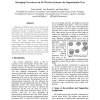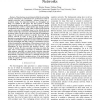51 search results - page 2 / 11 » Primary and secondary context in mobile video communication |
AICT
2005
IEEE
14 years 1 months ago
2005
IEEE
Integration of different radio access networks will become a reality in a near future. Our interworking architecture assumes a ubiquitous primary network (the cellular one) and se...
CHI
2006
ACM
14 years 7 months ago
2006
ACM
The mobile phone allowed people to communicate when and where they wanted, dramatically changing how audio telephony was integrated into daily life. With video telephony services ...
INFOCOM
2011
IEEE
12 years 11 months ago
2011
IEEE
—There has been recent interest within the networking research community to understand how performance scales in cognitive networks with overlapping n primary nodes and m seconda...
MOBIQUITOUS
2005
IEEE
14 years 29 days ago
2005
IEEE
Third generation mobile communication systems will provide more advanced types of interactive and distribution services, and video is one of the most prominent applications for mu...
DSN
2003
IEEE
14 years 20 days ago
2003
IEEE
The presence of physical obstacles and radio interference results in the so called “shadow regions” in wireless networks. When a mobile station roams into a shadow region, it ...


